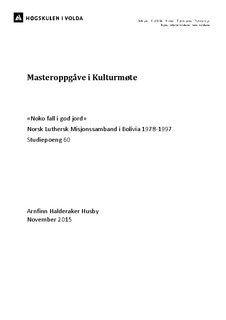| dc.contributor.advisor | | |
| dc.contributor.author | Husby, Arnfinn Halderaker | |
| dc.coverage.spatial | Bolivia | nn_NO |
| dc.coverage.temporal | 1978-1997 | |
| dc.date.accessioned | 2016-01-11T10:19:13Z | |
| dc.date.available | 2016-01-11T10:19:13Z | |
| dc.date.issued | 2015 | |
| dc.identifier.uri | http://hdl.handle.net/11250/2373255 | |
| dc.description.abstract | Summary
This essay will consider the missionary work to Norwegian Lutheran Mission in Bolivia, from the first start in 1978, and until a national church were established in 1997. How did the missionaries discussed their meetings with those Bolivian cultures? Did those meetings get any impact in how the missionaries developed their missionary work? Norwegian Lutheran Mission had long experience with missionary work in China and later from Ethiopia, but the missionaries who were sent out to Bolivia, had no experience before they started up their missionary work. They had to find their own ways to solve all sorts of challenges. Traditionally has Norwegian Lutheran Mission often worked mostly outside at the countryside, sometimes together with development projects. In the first part of the main chapter, we will follow those first missionaries on their journeys into the mountains to find the primary goal for the mission, the Quechuan peoples. Some villages rejected to have contact with the missionaries, but a drought disaster in 1983 opened many closed villages for evangelical preaching. Although some peoples showed interest, was it difficult to establish new congregations. Furthermore, in the main chapter, we follow the missionary work in the cities. It took time to get good connection with locals. Paul G. Hiebert says in his theory that any missionaries who wishes to get good contact need to live in repeated relationship in social and cultural communities over time for to winning contact and trust. After some years, someone of the missionaries had received usefully knowledge of those locale cultures, and they used their knowledges to do a great work with building bridges to the local culture. Local song and music was used in the worship of God, and new meeting places for social and cultural alternatives was introduced, named Fiesta Cristiana. After nineteen years of missionary work, it was time to give the work over to a new Lutheran church. The missionaries desired to transfer some of what they thought was good values from their own Norwegian church tradition. The missionaries did make some changes when they understood more of those deep levels of the local culture. Culture studies is just as important for a missionary such as theology. | en |
| dc.language.iso | nno | nb_NO |
| dc.publisher | Høgskulen i Volda | nn_NO |
| dc.subject | Norsk Luthersk Misjonssamband | nb_NO |
| dc.subject.ddc | 266.4148184 | |
| dc.subject.ddc | 266.00984 | |
| dc.subject.ddc | 303.482840481 | |
| dc.subject.ddc | 306.6664148184 | |
| dc.title | "Noko fall i god jord". Norsk Luthersk Misjonssamband i Bolivia 1978-1997 | nn_NO |
| dc.type | Master thesis | nb_NO |
| dc.subject.nsi | VDP::Social science: 200::Sociology: 220 | en |
| dc.subject.nsi | VDP::Social science: 200::Social anthropology: 250 | en |
| dc.subject.nsi | VDP::Humanities: 000::Theology and religious science: 150::Religious science, religious history: 153 | en |
| dc.source.pagenumber | 113 | |
| dc.subject.keyword | Fiesta Cristiana | es |
| dc.subject.keyword | tradisjonar religionsblanding synkretisme romersk-katolsk truande luthersk misjon quechua-talande indoamerikanske urfolk Bolivia kyrkjelydsbygging kulturmøte misjonærar | nn_NO |
| dc.subject.keyword | religionsblanding | nn_NO |
| dc.subject.keyword | synkretisme | nn_NO |
| dc.subject.keyword | romersk-katolske kristne | nn_NO |
| dc.subject.keyword | luthersk misjon | nn_NO |
| dc.subject.keyword | quechua-talande | nn_NO |
| dc.subject.keyword | indoamerikanske urfolk | nn_NO |
| dc.subject.keyword | Bolivia | nn_NO |
| dc.subject.keyword | kyrkjelydsbygging | nn_NO |
| dc.subject.keyword | kulturmøte | nn_NO |
| dc.subject.keyword | misjonærar | nn_NO |
